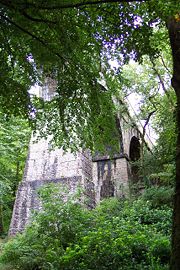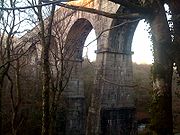
Luxulyan Valley
Encyclopedia



River Par
The River Par is a river draining the area north of St Blazey in Cornwall, in the United Kingdom.The Par is formed by several streams, rising near the villages of Lockengate, Lanivet and Tregullon near Bodmin, which flow southwards via the Bokiddick, Bodwen and Luxulyan areas to flow into the...
, situated in the south east of Cornwall
Cornwall
Cornwall is a unitary authority and ceremonial county of England, within the United Kingdom. It is bordered to the north and west by the Celtic Sea, to the south by the English Channel, and to the east by the county of Devon, over the River Tamar. Cornwall has a population of , and covers an area of...
, England. It contains a major concentration of early 19th century industrial remains, and was designated as part of a World Heritage Site
World Heritage Site
A UNESCO World Heritage Site is a place that is listed by the UNESCO as of special cultural or physical significance...
in 2006.
The valley stretches south-east from the village of Luxulyan
Luxulyan
Luxulyan , also spelled Luxullian or Luxulian, is a village and civil parish in central Cornwall, United Kingdom. The village lies four miles northeast of St Austell and six miles south of Bodmin...
50.390°N 4.744°W. It reaches as far as the edge of the built-up area around the town of St Blazey
St Blazey
St Blazey is a small town in Cornwall, United Kingdom.St Blaise is the civil parish in which St Blazey is situated; the name St Blaise is also used by the town council.St Blazey is situated east of St Austell...
and the port of Par
Par, Cornwall
Par is a town and fishing port with a harbour on the south coast of Cornwall, England, United Kingdom. The town is situated in the civil parish of Tywardreath and Par and is approximately east of St Austell. Par has a population of around 1,400.....
, a distance of some 5 km. It lies within the civil parishes of Luxulyan, Lanlivery
Lanlivery
Lanlivery is a village and civil parish in Cornwall, United Kingdom. The village is located approximately 1½ miles west of Lostwithiel and five miles south of Bodmin....
and Tywardreath
Tywardreath
Tywardreath is a small hilltop village in southern Cornwall, United Kingdom. about north west of Fowey. It is located in a sheltered spot overlooking a silted up estuary opposite Par and near the beach of Par Sands...
, and is one of the areas (designated A8i in the original nomination) of the larger, but discontinuous, Cornwall and West Devon Mining Landscape
Cornwall and West Devon Mining Landscape
The Cornwall and West Devon Mining Landscape is a World Heritage Site which includes select mining landscapes across Cornwall and West Devon in the south west of the United Kingdom...
World Heritage Site.
Most of the industrial remains in the valley are the results of the endeavours of Joseph Treffry
Joseph Treffry
Joseph Austen Treffry was an engineer, mining adventurer, and industrialist who became a significant landowner in Cornwall, United Kingdom.-Biography:...
(1782–1850). Copper
Copper
Copper is a chemical element with the symbol Cu and atomic number 29. It is a ductile metal with very high thermal and electrical conductivity. Pure copper is soft and malleable; an exposed surface has a reddish-orange tarnish...
mining was booming in the area during the early 19th century, and Treffry was the owner of Fowey Consols mine
Fowey Consols mine
Fowey Consols mine is a group of mines in the St Blazey district of Cornwall. They were owned by wealthy Cornishman, Joseph Treffry. The mines were worked by 6 steam engines and 17 waterwheels. The mines were linked to the port at Par by a canal...
, one of the deepest, richest and most important of the Cornish copper mines. The mine was situated to the east of the southern end of the Luxulyan Valley proper, and its site is part of the designated World Heritage Site. At its peak it was worked by six steam engine
Steam engine
A steam engine is a heat engine that performs mechanical work using steam as its working fluid.Steam engines are external combustion engines, where the working fluid is separate from the combustion products. Non-combustion heat sources such as solar power, nuclear power or geothermal energy may be...
s and 17 water wheel
Water wheel
A water wheel is a machine for converting the energy of free-flowing or falling water into useful forms of power. A water wheel consists of a large wooden or metal wheel, with a number of blades or buckets arranged on the outside rim forming the driving surface...
s.
In the late 1820s, Treffry built the port of Par Harbour. He then linked this to Pontsmill, at the southern end of the valley, by means of the Par Canal. A mineral tramway
Tramway (mineral)
Tramways are lightly laid railways, sometimes worked without locomotives. The term is in common use in the United Kingdom, New Zealand, and elsewhere. In New Zealand, they are commonly known as bush tramways...
connected the canal head to the mine. A second tramway followed in 1835, via an inclined plane
Cable railway
A cable railway is a steeply graded railway that uses a cable or rope to haul trains.-Introduction:...
, a flat route along the eastern lip of the valley, and the major Treffry Viaduct
Treffry Viaduct
The Treffry Viaduct is a historic dual-purpose railway viaduct and aqueduct, located close to the village of Luxulyan, Cornwall, England in the United Kingdom...
across the valley to Luxulyan. This second route served two major purposes, as it enabled Treffry to develop Carbeans and Colcerrow granite
Granite
Granite is a common and widely occurring type of intrusive, felsic, igneous rock. Granite usually has a medium- to coarse-grained texture. Occasionally some individual crystals are larger than the groundmass, in which case the texture is known as porphyritic. A granitic rock with a porphyritic...
quarries in the upper valley, and was also used by a leat
Leat
A leat is the name, common in the south and west of England and in Wales, for an artificial watercourse or aqueduct dug into the ground, especially one supplying water to a watermill or its mill pond...
carrying water to supply the mine at Fowey Consols. Two further granite quarries, known as Rock Mill and Orchard, operated lower down in the valley. In 1870 these were linked to Pontsmill by a third tramway along the valley floor.
The 1835 tramway eventually became part of the Cornwall Minerals Railway
Cornwall Minerals Railway
The Cornwall Minerals Railway operated a network of railway lines in Cornwall, United Kingdom. Based at St Blazey, its network stretched from Fowey to Newquay and lasted as an independent company from 1874 to 1896, after which it became a part of the Great Western Railway.-Authorisation:The...
which linked the English Channel
English Channel
The English Channel , often referred to simply as the Channel, is an arm of the Atlantic Ocean that separates southern England from northern France, and joins the North Sea to the Atlantic. It is about long and varies in width from at its widest to in the Strait of Dover...
ports of Par and Fowey
Fowey
Fowey is a small town, civil parish and cargo port at the mouth of the River Fowey in south Cornwall, United Kingdom. According to the 2001 census it had a population of 2,273.-Early history:...
with the china clay
Kaolinite
Kaolinite is a clay mineral, part of the group of industrial minerals, with the chemical composition Al2Si2O54. It is a layered silicate mineral, with one tetrahedral sheet linked through oxygen atoms to one octahedral sheet of alumina octahedra...
workings of central Cornwall, and to the Atlantic port of Newquay. As part of this process, the section of the route between Pontsmill and Luxulyan, with its incline and flat sections ideal for animal haulage, was replaced with a more gradually climbing route through the valley itself, more suited to locomotive
Locomotive
A locomotive is a railway vehicle that provides the motive power for a train. The word originates from the Latin loco – "from a place", ablative of locus, "place" + Medieval Latin motivus, "causing motion", and is a shortened form of the term locomotive engine, first used in the early 19th...
haulage. The newer route is still in use, as part of the Atlantic Coast Line
Atlantic Coast Line, Cornwall
The Atlantic Coast Line is a community railway line in Cornwall, United Kingdom. The line runs from the English Channel at Par, to the Atlantic Ocean at Newquay.-Route:The Atlantic Coast Line starts from Par station, in the village and port of Par...
, and passes beneath the spans of the Treffry Viaduct that carried its predecessor. The older tramway routes remained in use to serve the various granite quarries until the early 20th century. The last stone came from Carbeans in 1933 but a few sections of Treffry's rails can still be found.
The thickly-wooded terrain of the Luxulyan Valley also played a major part in the early tin
Tin
Tin is a chemical element with the symbol Sn and atomic number 50. It is a main group metal in group 14 of the periodic table. Tin shows chemical similarity to both neighboring group 14 elements, germanium and lead and has two possible oxidation states, +2 and the slightly more stable +4...
mining industry of Cornwall. The woods were important for making the charcoal
Charcoal
Charcoal is the dark grey residue consisting of carbon, and any remaining ash, obtained by removing water and other volatile constituents from animal and vegetation substances. Charcoal is usually produced by slow pyrolysis, the heating of wood or other substances in the absence of oxygen...
that was needed in large quantities for smelting tin from the rich alluvial deposits on the moors to the northwest. Charcoal-burning platforms are to be found close to nearby Prideaux Castle
Prideaux Castle
Prideaux Castle is a quadrivallate Iron Age hillfort situated atop a 133 m high conical hill near the southern boundary of the parish of Luxulyan, Cornwall, in the United Kingdom...
.

